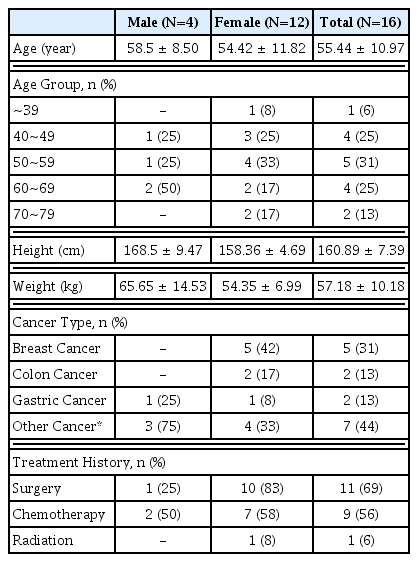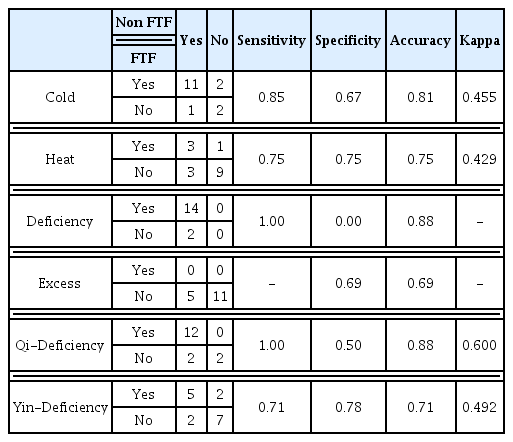References
1. An K. The system of symptom differentiation and the contents in Oriental Medicine. Korean J of Orient Physiology & Pathology 1987;2(1):6–12.
2. Yeo M, Park K, Jang E, Lee Y. A national survey on utilization of pattern identification among Korean medicine doctors. Journal of Society of Preventive Korean Medicine 2015;19(3):45–55.
3. 전국한의과대학병리학교실, 한방병리학. 일중사. 2004;
4. Yeo MK, Lee YS. Analysis of Clinical Research Trends on Cold-Heat Pattern Identification in Korea-Focused on Quantitative Indicators for General People. Journal of Physiology & Pathology in Korean Medicine 2017;31(2):145–52.
5. Ryu H, Lee H, Kim H, Kim J. Reliability and validity of a cold–heat pattern questionnaire for traditional Chinese medicine. The Journal of Alternative and Complementary Medicine 2010;16(6):663–7.
6. Jang ES, Yoon JH, Baek YH, Lee SW. Evaluation of Reliability and Validity for Deficiency and Excess Pattern Identification Questionnaire. Journal of Physiology & Pathology in Korean Medicine 2018;32(3):171–7.
7. Lin SC, Chen MF, Li TC, Hsieh YH, Liu S-J. The distribution of yin-deficient symptoms and their relationship on survival rate in cancer patients with Yin-Deficiency. The American Journal of Chinese Medicine 2008;36(04):655–63.
8. Zhu YJ, Zhang HB, Liu LR, Liu YH, Zhang FL, Bai JP, et al. Yin-cold or yang-heat syndrome type of traditional Chinese medicine was associated with the epidermal growth factor receptor gene status in non-small cell lung cancer patients: confirmation of a TCM concept. Evidence-Based Complementary and Alternative Medicine 2017;2017.
9. Jiao L, Xu J, Sun J, Chen Z, Gong Y, Bi L, et al. Chinese herbal medicine combined with EGFR-TKI in EGFR mutation-positive advanced pulmonary adenocarcinoma (CATLA): a multicenter, randomized, double-blind, placebo -controlled trial. Frontiers in Pharmacology 2019;10:732.
10. Oh S, Park Y, Park Y. Studies on the characteristics of the Yin-Yang, Heat-Cold by the Yangdorak patterns. J Korea Instit Orient Med Diagn 2003;8(1):86–108.
11. Bae KH, Yoon YH, Yeo MK, Kim HS, Lee YS, Lee SW. Development on the Questionnaire of Cold-Heat Pattern Identification Based on Usual Symptoms for Health Promotion-Focused on Agreement Study. Journal of Society of Preventive Korean Medicine 2016;20(2):17–26.
12. Kim SH, Kim JU, Jeon YJ, Kim KH, Kim JY. Method for determining the deficient and solid pulse with a new pulse wave parameter. Journal of Physiology & Pathology in Korean Medicine 2010;24(1):42–7.
13. Baek SW, Lee JM, Park YB, Park YJ. Relationship between tongue temperature estimated by infrared thermography, tongue color, and cold-heat pathological patterns: a retrospective chart review study. Evidence-Based Complementary and Alternative Medicine 2018;2018.
14. Kim J, Park SJ, Yoon J, Lee BJ, Kim KH. Association of Cold-Heat Patterns with Tongue Features, Body Composition, Anthropometric Indices, and Blood Parameters in Tae-Eum Type. Evidence-Based Complementary and Alternative Medicine 2018;2018.
15. Kim JY, Lee KI. Advantages and Necessities of Telehealth Care Service. The Korean Journal of Medicine 2020;95(4):217–27.
16. Bae KH, Park KH, Lee YS, Jang ES. Important Items Extracted through the Questionnaire of Cold and Heat Pattern Identification by the Experts’ Agreement. Journal of Physiology & Pathology in Korean Medicine 2016;30(6):466–73.
17. Bae KH, Jang ES, Park K, Lee Y. Development on the Questionnaire of Cold-Heat Pattern Identification Based on Usual Symptoms: Reliability and validation Study. Journal of physiology & pathology in Korean Medicine 2018;32(5):341–6.
18. Yoon Y, Kim H, Lee Y, Yoo J, Lee S. Developing an optimized cold/heat questionnaire. Integrative Medicine Research 2015;4(4):225–30.
19. Woo HJ, Kim SH, Lee SB, Choi MY, Kim Y-C, Lee JH. Development of Questionnaires for Differentiation of qì-xū, xuè-xū, yang-xū, yīn-xū analysis. The Journal of Internal Korean Medicine 2008;29(4):856–70.
20. Kim JH, Ku BC, Kim JE, Kim YS, Kim KH. Study on Reliability and Validity of the’Qi Blood Yin Yang Deficiency Questionnaire’. Journal of Physiology & Pathology in Korean Medicine 2014;28(3):346–54.
21. Yeo MK, Dong SO, Lee YS, Jang ES. Review on Reliability and Validity of Questionnaire of Pattern Identification in Traditional Chinese Medicine-Using China National Knowledge Infrastructure. Journal of Physiology & Pathology in Korean Medicine 2015;29(3):246–55.
22. Park Y, Park Y. A study on standardization of Bian Zheng by some statistical methods. The Journal of the Korea Institute of Oriental Medical Diagnostics 2001;5(2):306–30.
23. 田桢 . 吉非替尼治疗 58 例 EGFR 突变晚期肺腺癌疗效与中医寒热病性相关性研究 北京中医药大学; 2012.
24. Ma J, Liu H, Zhou C. Research on the relationship between chinese medical syndrome types and Th1/Th2 in bronchioloalveolar carcinoma by thoracoscopic technique. Zhongguo Zhong xi yi jie he za zhi Zhongguo Zhongxiyi jiehe zazhi= Chinese journal of integrated traditional and Western medicine 2013;33(8):1069–71.
25. 李际强 , 徐凯 , 罗翌 , 曾普华 , 方志坚 , 欧爱华 , et al. 肺癌患者中医证候分型与 T 淋巴细胞亚群及 NK. 细胞的相关性研究. 江西中医学院学报 2007;19(4):36–9.
26. Park JJ, Lee MS, Kong KH, Go HY. Relationship between heart rate variability and Cold-Heat patternization in patient with chronic constipation. The Journal of Internal Korean Medicine 2012;33(2):209–21.
27. Lee S-W, Joo J-C, Kim K-Y, Kim J-Y. Clinical study on the Sasang constitutional pulse using array piezoresistive sensor. Journal of Sasang Constitutional Medicine 2006;18(1):118–31.
28. Landis JR, Koch GG. The measurement of observer agreement for categorical data. biometrics 1977;:159–74.
29. Fleiss JL, Levin B, Paik MC. Statistical methods for rates and proportions john wiley & sons; 2013.
30. Jang E, Lee EJ, Yun Y, Park YC, Jung IC. Suggestion of standard process in developing questionnaire of pattern identification. Journal of Physiology & Pathology in Korean Medicine 2016;30(3):190–200.
31. Jang E, Kim Y, Lee EJ, Yoo HR. Review on the development state and utilization of pattern identification questionnaire in Korean medicine by U code of Korean Classification of Disease. Journal of Physiology & Pathology in Korean Medicine 2016;30(2):124–30.




